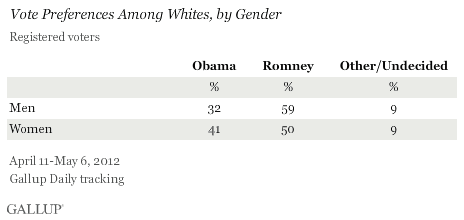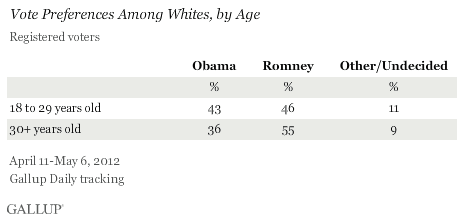PRINCETON, NJ -- Because the overwhelming majority of nonwhite registered voters in the U.S. vote Democratic -- 77% currently support Barack Obama for president -- likely Republican nominee Mitt Romney must do well among white registered voters in order to offset this advantage. Among non-Hispanic whites, Romney currently leads by 54% to 37%, with 9% undecided.

The findings are based on the first 25 days of Gallup Daily tracking of the general election, from April 11-May 6. Over this period, Obama and Romney were tied, 46% to 46%, in the preferences of the more than 11,000 registered voters interviewed.
Obama currently has the support of 90% of blacks, 68% of Hispanics, and 57% of other races, including Asians. The preferences of these nonwhite voters are fairly uniform by gender, education, religiosity, and other demographic variables.
This is not the case with whites, among whom such demographic differences starkly divide voters in terms of whom they support. Gallup's large sample of more than 9,000 non-Hispanic whites interviewed over the more than three-week period ending May 6 provides a unique opportunity to examine the most important demographic distinctions with a high degree of statistical reliability.
Being "Nonreligious" Makes a Difference
White Americans' degree of religiousness is a major predictor of their vote, with the biggest divergence between those who are at least somewhat religious (66% of white voters in the April 11-May 6 sample) and those who are nonreligious (33%). White voters who are either very or somewhat religious -- based on their self-reports of the importance of religion and church attendance -- prefer Romney over Obama by 62% to 29%. White voters who are classified as nonreligious -- those who do not attend religious services regularly and who say religion is not important in their daily lives -- favor Obama by 54% to 38%.

This is a remarkable divergence of support. Among those who are nonreligious, support for Romney is 16 percentage points lower and support for Obama is 17 points higher than among all white voters.
The basic relationship between religiosity and partisanship in contemporary American political life has been well established. But the current data underscore the degree to which religiosity divides the political orientation of white voters today.
Never-Married Americans Differ From Others
The biggest differences among whites by marital status occur between those who are single/never married or living with a domestic partner and those of all other marital statuses, including married, separated, divorced, or widowed. White Americans who are currently married or were married in the past prefer Romney over Obama by 23 points, 57% to 34%. The single/domestic partner group favors Obama by eight points, 49% to 41%.

Postgraduates in a Class of Their Own
Many political observers make a distinction between the roughly one-third of Americans who are college educated and the remaining two-thirds who are not. In reality, the Gallup data show that the stronger dividing line among whites on the basis of education is between those with postgraduate education and all others. Whites with postgraduate education -- about 17% of all white voters -- support Obama over Romney by nine points, 52% to 43%. Whites from all other educational backgrounds support Romney by 22 points, 56% to 34%.

While "postgraduates" includes people in a broad assortment of professions and areas of academic specialty, the overall political bent of this group is decidedly more Democratic -- as well as more liberal and less religious -- than the rest of the adult population.
Romney Holds Commanding Lead Among White Men
Romney leads Obama among white voters of both genders, but does significantly better among men than among women. Among white men, Romney leads by 27 points, 59% to 32%. Among white women, he leads by nine points, 50% to 41%.

Young Voters Up for Grabs
The major distinction in candidate support by age among whites is between those 18 to 29 and those 30 and older. Young white adults still support Romney over Obama, but by a narrow 46% to 43% margin. Those 30 and older support Romney by 55% to 36%.

One of the reasons Obama does well among young voters overall is because young voters include a larger percentage of nonwhites than older age groups do.
Implications
In Gallup's 11,000 interviews with registered voters conducted from April 11-May 6, President Obama and former Massachusetts Gov. Romney were tied at 46% in the preferences of registered voters nationally. Thus, given the broader political and economic climate, many observers believe the race could remain close through the very end. In order to win, each candidate will have to energize his core voter constituent groups to turn out and vote, and pick up more support from some of his less solid support groups.
The data reviewed here provide a broad indication of the two candidates' electoral strengths and weaknesses. Obama clearly benefits from the solid base of support provided by nonwhites, and from there outperforms Romney among smaller segments of whites who are nonreligious, single, or have postgraduate education. He also does fairly well among white women and 18- to 29-year-olds, although Romney leads among these groups.
Romney has no equivalent to Obama's vast support from nonwhites. However, he makes up for that with solid leads among several significant sectors of the white population, including men, adults 30 and older, religious Americans, those who are married or have been married, and those with up to a college degree.
Obama won the 2008 election by a seven-point margin over John McCain, and enjoyed a slightly wider advantage than that in Gallup's final pre-election polling based on registered voters. Thus, it appears that at this point in the election cycle, the incumbent president has lost ground with the electorate he won over in 2008.
Gallup will continue to track differences in candidate support by race, religion, and other demographics, posting new weekly averages on the Election 2012 page. Future Gallup analyses will also explore trends in support by group and more detailed combinations of these demographic variables.
Sign up to get Election 2012 news stories from Gallup as soon as they are published.
Survey Methods
Results are based on telephone interviews conducted as part of Gallup Daily tracking April 11-May 6, 2012, with a random sample of 11,141 registered voters, aged 18 and older, living in all 50 U.S. states and the District of Columbia.
For results based on the total sample of registered voters, one can say with 95% confidence that the maximum margin of sampling error is ±1 percentage point.
Sample sizes and margins of error for subgroups of registered voters are shown below.

Interviews are conducted with respondents on landline telephones and cellular phones, with interviews conducted in Spanish for respondents who are primarily Spanish-speaking. Each sample includes a minimum quota of 400 cell phone respondents and 600 landline respondents per 1,000 national adults, with additional minimum quotas among landline respondents by region. Landline telephone numbers are chosen at random among listed telephone numbers. Cell phone numbers are selected using random-digit-dial methods. Landline respondents are chosen at random within each household on the basis of which member had the most recent birthday.
Samples are weighted by gender, age, race, Hispanic ethnicity, education, region, adults in the household, and phone status (cell phone only/landline only/both, cell phone mostly, and having an unlisted landline number). Demographic weighting targets are based on the March 2011 Current Population Survey figures for the aged 18 and older non-institutionalized population living in U.S. telephone households. All reported margins of sampling error include the computed design effects for weighting and sample design.
In addition to sampling error, question wording and practical difficulties in conducting surveys can introduce error or bias into the findings of public opinion polls.
For more details on Gallup's polling methodology, visit www.gallup.com.
